#hoodwinker sunfish
Text
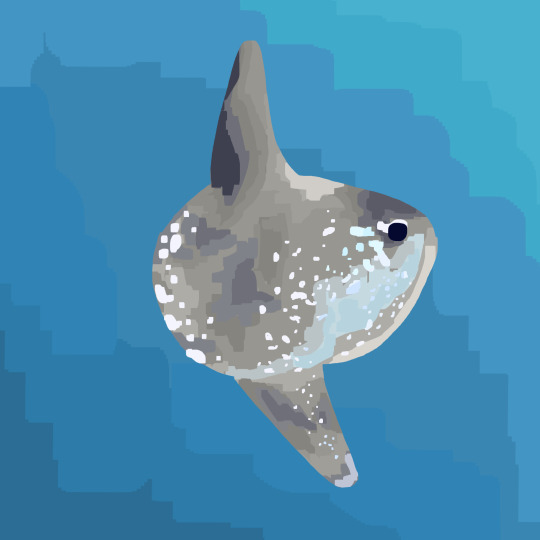

ok day 13 is big fish and i couldnt decide so hoodwinker sunfish (I LOVE SUNFISH!!! I LOVE SUNFISH) and my attempt at a coelacanth!!!
#teehee#i think they turned out cute#coelacanth is pretty big..#art#drawing#digital art#marine life#marine animals#marine biology#coelacanth#mola mola#sunfish#hoodwinker sunfish#fishuary2024
621 notes
·
View notes
Photo

Mola mola. The mola we all knowla. The mola we all molove. What an incredible creature, Mola mola is! Such a strange shape, so many eggs, no swim bladder... and the size. Its most prized aspect! If you know one thing about Mola mola, it’s that it is the largest bony fish, right?
...Right?
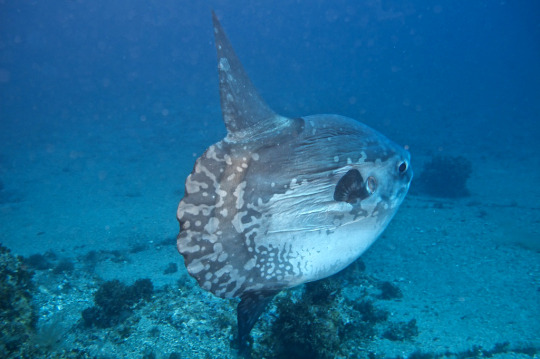
Nuh-uh-uh, Mola mola. Don’t try and sneak away. It’s very noticeable. After all, you are one of the biggest bony fish!
Let me repeat that. One of the biggest bony fish.
Mola mola, the ocean sunfish, is NOT in fact the largest known bony fish! You’d think we were talking about Mola tecta, because this sunfish has hoodwinked us!
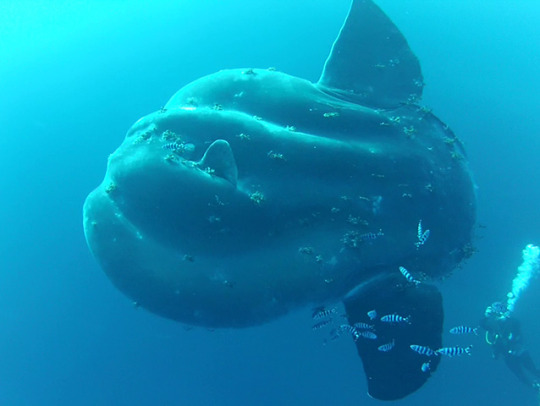
Behold MOLA ALEXANDRINI! Known, very appropriately, as the giant sunfish. This is the true heaviest bony fish! Not Mola mola, as has so been thought, and as I have even claimed in front of all of you. I was wrong! Mola alexandrini has been recorded weighing up to 6,049 pounds, with Mola mola trailing in the measly little 2,000s range. But if Mola alexandrini can be so much bigger, how was Mola mola seen as the champion for so long?
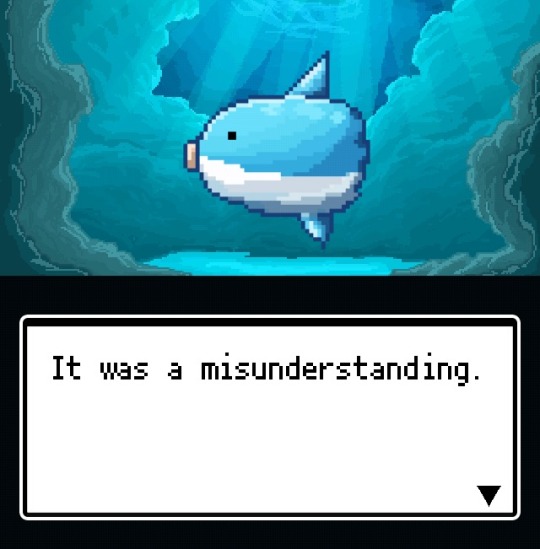
It was a misunderstanding. A misidentification! That huge specimen was caught all the way back in 1996, but thought to be Mola mola until it was reevaluated in 2017! Members of the Mola genus are just always accidentally tricking us humans. I’m sure they would say “sooorry” in a deep and booming, yet slow and gentle voice if they knew.
So how can you #KnowYourMolas? It is easy to confuse them- even scientists do it- but generally, be sure to notice the shapes of both the face and the clavus (the funny butt fin)! If the face is relatively smooth, and especially if the clavus has a scalloped shape, that’s Mola mola. If the face is bulgy and bumpy and the clavus is smooth and round, that’s Mola alexandrini! And if the face is smooth but the clavus is too, then you have been hoodwinked by Mola tecta!
So there you have it. The truth about the Mola mola! Not the biggest after all... but that does not matter to me. Mola mola will always be my favorite! That being said, please show Mola alexandrini some love too, as despite its size, it is still a lesser known Mola!
And who knows? Maybe even alexandrini will be dethroned! Maybe we will find a bigger alexandrini, or maybe a bigger mola! Maybe even a different species altogether is the true largest bony fish! There is no way to know what the future has in store... so many secrets in the ocean!
Refer here for more information on the updated identification!
#mola mola#mola alexandrini#mola tecta#molidae#mola#ocean sunfish#giant sunfish#hoodwinker sunfish#april fools#not mario#fish#mod chikako
2K notes
·
View notes
Text
Daily fish fact #458
Hoodwinker sunfish!
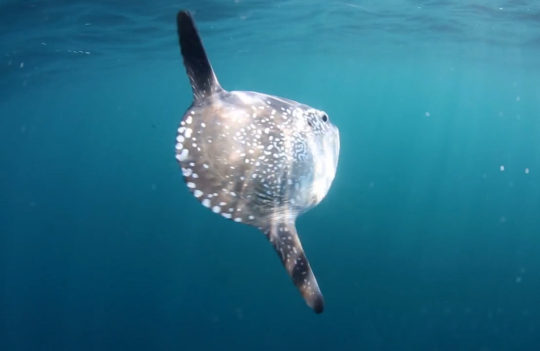
This species was only found very recently, as it was mistaken for other ocean sunfishes! Its scientific name, Mola tecta, references that, as "tecta" comes from the Latin word "tectus" which means hidden or disguised. However, it is distinguishable from other species as it is slimmer and lacks a lot of the "lumpiness" some of the other species have.
#mwahaha! another ocean sunfish fact! i am unstoppable!#fish#fishfact#fish facts#fishblr#marine biology#marine life#marine animals#sea creatures#sea animals#sea life#biology#zoology#hoodwinker sunfish#sunfish#mola tecta#oh and by ocean sunfish i literally mean sunfish that is found in the ocean! “ocean sunfish” of course means the mola mola#i wanted to distinguish between freshwater and saltwater sunfish because theyre completely different but i now see how that tag could be-#read wrong whoops
367 notes
·
View notes
Text
she

on my
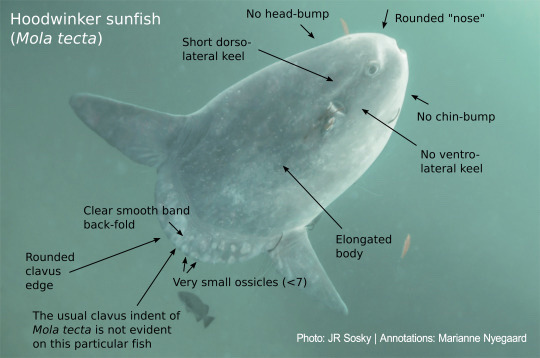
til i
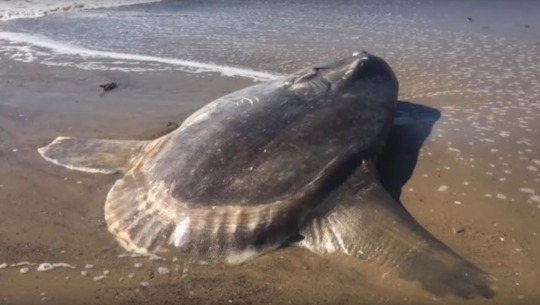
115 notes
·
View notes
Text
Wet Beast Wednesday: ocean sunfish
Everybody knows ocean sunfish, right? Those giant, slow, silly-looking, parasite-ridden morons that eat jellyfish and can't defend themselves from predators really are the worst fish right?

(GIF: Lex Luthor screaming "WRONG!" from the movie Superman Returns)
First of all there's no such thing as a "best" or "worst" animal and judging animals by human standards of what is cool or successful is silly because our standards are not even universal among humans, let along other species. Secondly, the closest thing we have to a way to judge a species is how successful it is in its niche and sunfish are doing pretty good, thank you very much. Today I'll be talking about sunfish and how they are not bad fish at all.
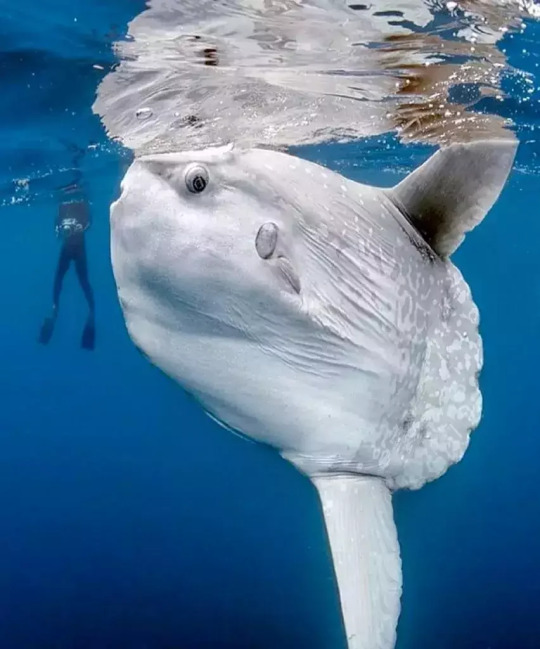
(Image: a Mola mola located near the surface of the ocean, with the tip of its dorsal fin and part of its head breaching the surface. It is a round fish with no tail, only a wrinkly region of its body. Its dorsal and anal fins are long and slender The eyes and mouth are proportionately small. It is a pale white with light grey spots. A SCUBA diver is visible in the background. End ID)
Ocean sunfish, or molas, are members of the family Molidae, which is divided into five known species across three genuses. Im mostly going to be talking about members of the genus Mola, but I'll mention the other two as well. Molas are known for their size and odd appearances, looking like someone chopped a fish in half and the front half went swimming off on its own. They are members of the order Tetraodontiformes, making them cousins to pufferfish, triggerfish, boxfish, and others. While many members of that order are known to be highly poisonous, molas are not. They also lack several other common traits. Despite being bony fish, most of the mola skeleton is made of cartilage and they do not have swim bladders, forcing them to actively swim to maintain their position in the water column. Instead of a tail and caudal fin, sunfish have a structure called the clavus. The clavus is formed mostly from connective tissue and is used as a rudder. Because the clavus is mostly made of connective tissue, damage to it is not particularly harmful to the fish. There have been molas found alive and well that have had portions of their clavus eaten by predators. Because of their shortened stature, molas have the fewest vertebrae of all fish. The dorsal and anal fins are elongated and are used to provide propulsion by flapping back and fourth similarly to how birds wings move, albeit slower. Minute alterations in the angle each fin moves through the water help with steering, while more sharp turns are aided with jets of water ejected through the mouth and gills. Like their other Tetraodintid relatives, mola teeth are fused together into a beak-like structure that prevents them from closing their mouths. They also have some more regular pharyngeal teeth in the backs of their mouths. Some reports say that the fish can make noises by grinding the pharyngeal teeth together. Mola skin is thick and rough, described as being similar to sandpaper in texture. Like most fish, the skin is covered in a layer of protective mucus.

(Image: a mola sunbathing. It is positioned with one side of its body facing the surface. Its body is just under the water's surface. End ID)
The three species in the genus Mola are Mola mola, the ocean sunfish and most well-known of the molas, Mola alexandrini, the giant, southern, or bumphead mola, and Mola tecta, the hoodwinker sunfish. Mola mola has an average weight of 247 to 1000 kg (545 to 2205 lbs), mouth to clavus length of 1.8 m (5.9 ft) and dorsal to anal fin length of 2.5 m (8.2 ft), though some individuals can get much large. The largest individual on record had a length of 3.3 m (10.8 ft), height of 3.2 m (10.5 ft) and weighed 2300 kg (5100 lbs). M. alexandrini is the largest of the species. The largest known southern sunfish measured in at 2744 kg (6049 lbs) and 3.25 m (10.66 ft) from mouth to clavus, making it the largest known bony fish in the world. They can be distinguished from M. mola by the presence of bumps on the forehead and chin, a more rounded clavus, and differently-shaped scales. M. tecta is known as the hoodwinker sunfish because it was long mistaken for one of the other two species and was only identified as a separate species in 2015 after the body of one washed up in Christchurch, Aotearoa/New Zealand and was examined by scientists. Because it has only recently been discovered, little is known about this species. They appear to have the same range of sizes and weights of the other two species and can be distinguished by a slimmer body shape and a smooth clavus. All three species are found in tropical and temperate waters worldwide, though M. alexandrini and M. tecta are more commonly found in the southern hemisphere.
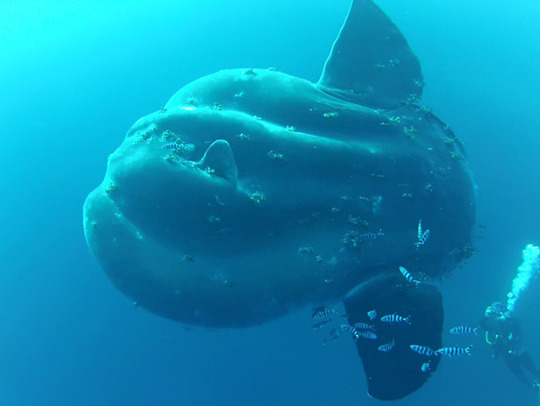
(Image: a Mola alexandrini underwater. It is distinguishable from Mola mola by the two bumps above and below its facial region, making it look lumpy. It is surrounded by striped cleaner fish. A SCUBA diver is in the background. End ID)
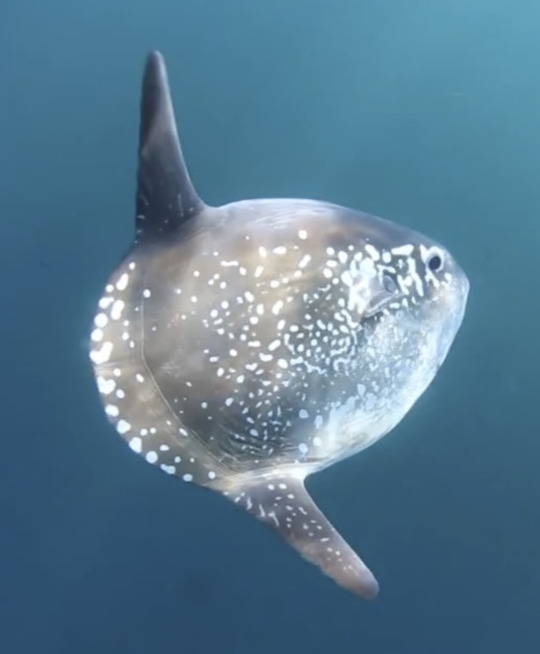
(Image: a Mola tecta seen from the side. It is smoother than the other two species. More of its body is grey with white spots. End ID)
Molas are open-ocean dwellers that live life in the slow lane. For a long time, it was believed they were moved around by ocean currents they could not swim against, making them plankton. We now know they not only can swim against the current, they are capable of bursts of speed fast enough to breach the water's surface and briefly go airborne. Sunfish are named for their habit of basking at the surface of the water. It was formerly believed they spent most of their time at the surface, but thanks to tagging, we know they make frequent dives into the deep ocean. They likely bask at the surface to warm up between dives. You may not expect something as slow as a sunfish to be a predator, but they are. Much of their diet consists of gelatinous animals including jellyfish, siphonophores, ctenophores, and salps, though they will also eat small fish, fish larvae, squids, crustaceans, and even seagrass. Because they can't chew, sunfish move prey into and out of their mouth by rapidly switching between sucking water in and spitting it out in order to shred the prey into pieces small enough to swallow. Special mucus lining the digestive system may protect the molas from the stinging tentacles of their prey. Molas and other jellyfish-eaters like the leatherback sea turtle play an important role in the ecosystem by keeping jellyfish populations down. Jellyfish are not particularly nutritious, so the sunfish need to eat a lot of them to survive, something they seem to be pretty good at. Being slow and having a very low-energy lifestyle helps the fish survive on a less-nutritious diet, making them very energy efficient. One thing molas get a lot of flack for online is having lots of parasites (with up to 40 known species). This doesn't really make sense. Every species has parasites. An animal in the wild that doesn't have parasites is vanishingly rare. Having parasites doesn't make an animal suck, it makes them ordinary. Because of their parasite load, molas are frequent visitors to cleaner fish, who will eat their parasites. Molas will also let seabirds land on them and eat their parasites while they rest on the surface. The molas attract birds by splashing at the surface. Adult molas have few natural predators, but are hunted by sharks, sea lions, and orcas. Interestingly, sea lions have been known to kill molas apparently for sport, ripping off the fins and then leaving the mola to die.

(Image: a mola seen from the front. Multiple smaller fish are picking parasites off of its skin. End ID)
Molas are broadcast spawners who release their gametes into the water alongside each other. A female mola can release 300 million eggs at a time, more than any other vertebrate. Newly hatched sunfish are 2.5 millimeters long and are often cited as having the largest discrepancy in size between juvenile and adult of any vertebrate. An adult mola can be 60 millions times the weight of a larva. The larvae look very different than adult, lacking their dorsal and anal fins but having pufferfish-like spines. Juveniles school together for protection and become solitary as they age. The diet of the fish varies as they age, with younger fish feeding more on squid, worms, crustaceans, and fish but becoming more reliant on jellyfish and other gelatinous prey as they age. We don't know the growth rate of molas, but a juvenile in the Monterey Bay Aquarium grew from 26 to 339 kg (57 to 880 lbs) in 15 months, suggesting they grow rapidly. The maximum age of molas is unknown, though individuals in captivity have lives for up to 10 years.

(Image: a mola larva. It is a brown ball with large, black eyes and no visible fins. It is covered in transparent, conical spines. End ID)
The two non-Mola sunfish are Ranzania laevis, the slender sunfish and Masturus lanceolatus, the sharptail sunfish. Both are alone in the genuses, but other species are suspected. I also found references to other species in Masturus, but could find literally no information about them other than that Masturus oxyuropterus is listed in some records. The sharptail sunfish looks very similar to Mola mola and reaches similar sizes, but its clavus has an extension that looks like a short tail. They were initially believed to be deformed molas before being recognized as a separate species. Unlike molas, sharptail sunfish are rarely seen at the surface, preferring to stay in deeper water. The slender sunfish is the smallest of the family, reaching up to a meter long. While we don't know much about them, we know their diet includes a lot of fast-moving squid, indicating they can move faster than their much larger relatives.
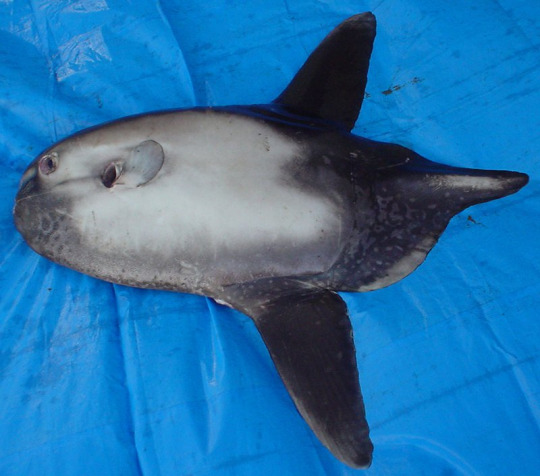
(Image: a sharptail sunfish lying on a blue tarp. It looks similar to a Mola mola , but with black clavus and fins. At the back of the clavus is a triangular extension. End ID)
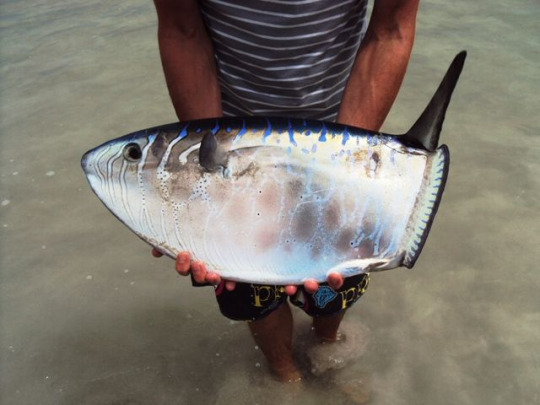
(Image: a person holding a slender sunfish. The fish is small enough to be held and has a longer and skinnier body than other sunfish. Its body is a shiny silver with blue lines. End ID)
Mola mola is classified as vulnerable by the IUCN while the other species are classed as either data deficient or least concern. Molas are vulnerable to strikes by boats and bycatch. Another danger to them is plastic bags, which can easily be ingested after being mistaken for a jellyfish. The bags can suffocate the fish or block their digestive tracts. Despite their size, molas are docile and not dangerous to humans. I found one example of a mola harming a human and it happened when the fish jumped out of the water and landed on a boat. Allegedly, some fish have learned to recognize and approach SCUBA divers. Molas are difficult to keep in captivity due to their size, the amount of space the need, and special feeding needs, so only a few aquariums have them. Molas are captured for food, with the biggest markets being in Taiwan and Japan, where they are often called mambos.
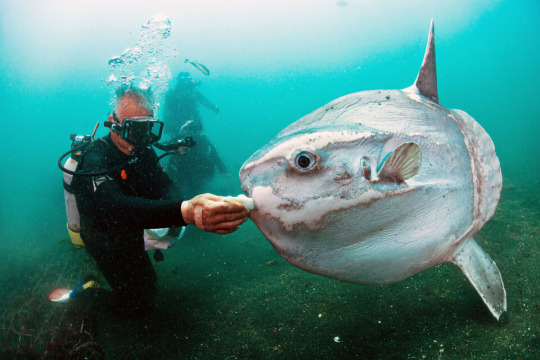
(Image: a SCUBA diver attempting to hand feed a small mola. End ID)
#wet beast wednesday#ocean sunfish#mola mola#name so nice you say it twice#countering sunfish slander#mola alexandrini#mola tecta#sharptail mola#Masturus lanceolatus#slender sunfish#Ranzania laevis#fish#fishblr#fishposting#marine biology#biology#zoology#ecology#animal facts#image described
171 notes
·
View notes
Text
An ASCII overview of the Molidae fish family:
Common sunfish
Mola mola
|\
Σ  ̄ ̄\
Σ C ° 3
Σ ____/
|/
Bumphead sunfish
Mola alexandrini
|\
Σ  ̄ ̄)
Σ C ° 3
Σ ___/
|/
Hoodwinker sunfish
Mola tecta
|\
Σ || ̄ ̄\
Σ= C ° 3
Σ ||____/
|/
Sharptail sunfish
Masturus lanceolatus
|\
Σ  ̄ ̄\
< C ° 3
Σ ____/
|/
Slender sunfish
Ranzania laevis
|\_______
( •o•
|/ ̄ ̄ ̄
#monterey bay aquarium#mola#molidae#mola mola#mola tecta#mola alexandrini#masturus lanceolatus#ranzania laevis#ocean sunfish#common sunfish#hoodwinker sunfish#bumphead sunfish#sharptail sunfish#slender sunfish#ascii me anything
10K notes
·
View notes
Photo

A conservationist examines a beached hoodwinker sunfish at Coal Oil Point Reserve in Santa Barbara, California. It is the first time this species has been seen in the northern hemisphere in 130 years
Photograph: Thomas Turner/UC Santa Barbara/AP
(via The week in wildlife – in pictures | Environment | The Guardian)
This individual was first reported on iNaturalist.
#Hoodwinker Sunfish#Mola tecta#Mola#Molidae#Tetraodontiformes#Actinopterygii#Osteichthyes#fish#sunfish#beach#citizen science#California
57 notes
·
View notes
Text
Holy Mola Tecta!
Above is the link to a crazy-cool story on how this 7-foot, "Hoodwinker Sunfish," (aka Mola Tecta) was recently found, and identified as such, a whole hemisphere away from where it has ever been seen before! This Mola Tecta, or Hoodwinker Sunfish, took a while to be thoroughly examined and accurately identified. Once it was identified as such, an amazing discovery was made! The discovery of this subspecies was made a couple of years ago, in the ocean waters around Australia! A UCSB intern, who took a morning walk on the beach, reported back immediately! Also, it's great how the right people came together on iNaturalist, an application that helped UCSB biologists (University of California, Santa Barbara) connect with experts on this particular fish... who were located in New Zealand and Australia! Using the application they were able to correctly identify the subspecies! The Mola Mola is a more common sunfish around there, so that was the first suspect. They had to be sure, and all involved, were hoodwinked by this Hoodwinker Sunfish from the southern hemisphere. This was a fish who made a very long journey to a gorgeous resting place, if I do say so myself. Santa Barbara's coastal areas are gorgeous and, if I was a fish, I would go there to live out my final hours or days as well!
P.S. Great job to all involved with this find, ID, and to Fox News for writing up an article about this story. I am glad to know that there are still good things in the news these days, sometimes.
P.P.S. Thanks for reading my geeked out brain's interpretation of what happened. I tried to have some fun with it while staying true to facts. It is late so if there are typos, I'm sorry..but I was too excited not to share!
#goscience
#ucsb#ucsb marine biology#mola tecta#giant sunfish#hoodwinker sunfish#hoodwinker#fish#sunfish#giant fish#monster sunfish#marine biology#california#cool fish#mola tecta sunfish
2 notes
·
View notes
Note
heyo hecko
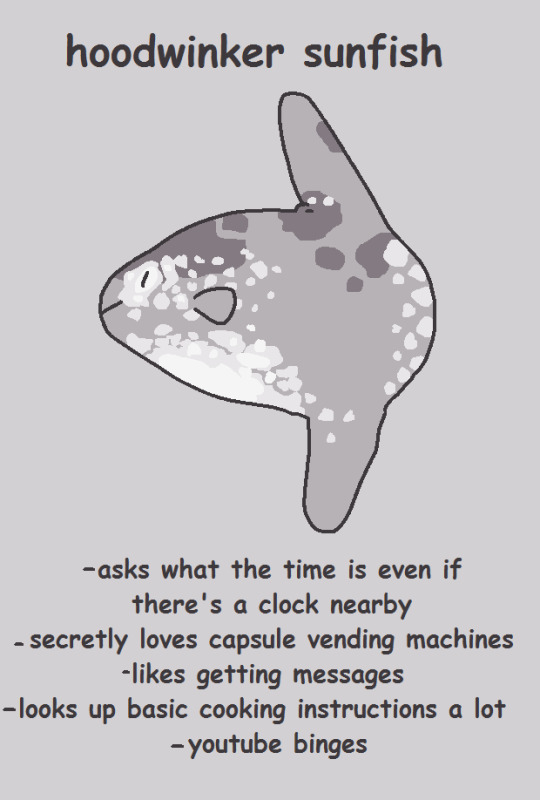
#answering stuff#closeted-cryptid#oceanic sunfish#hoodwinker sunfish#first impression animal meme#a Big Friend#shitpost#my art
9 notes
·
View notes
Photo

RISE THE SUNFISH: RESEARCHERS UNCOVER NEW SPECIES OF GIGANTIC BONYFISH
Probably you heard about the new species of sunfish discovered by scientists in New Zealand! We are excited, because is the first addition to the Mola genus in 125 years
Previously undescribed, the new especies of sunfish it's called the Hoodwinker Sunfish (Mola tecta). Marianne Nyegaard, an australian researcher made the discovery while researching the population genetics of ocean sunfish off the coast of Bali in Indonesia. She and her team spent four years searching for the fish, after genetic sequencing of 150 specimens in her research turned up with a new different species with remarkable body features.
The species name tecta is derived from the Latin tectus (disguised, hidden), as this species evaded discovery for nearly three centuries, despite the keen interest among early sunfish taxonomists and the continued attention these curious fish receive. While the English name, ‘Hoodwinker’, pertains to the figurative meaning ‘trickster, deceiving by disguise’, c. 1600. According to Nyergaard the Hoodwinker sunfish is thought to be widely distributed in all the world’s oceans except for the polar seas, however may be relatively uncommon in some areas, for example around Australia and New Zealand.
The taxonomy of ocean sunfishes (Family Molidae) has a complicated history, partially because they are so difficult to preserve and study, even for museums. If you don’t believe me, please look at this preserved common ocean sunfish (cf. Mola mola) at the National History Museum in Santiago de Chile.

Imagen: César Villarroel
Reference (Open Access): Nyegaard et al., 2017Hiding in broad daylight: molecular and morphological data reveal a new ocean sunfish species (Tetraodontiformes: Molidae) that has eluded recognition. Zoological Journal of the Linnean Society.
#chiquillos del museo porfa perdonenme#molidae#tetraodontidae#animals#biology#marine biology#new species#tenia que hablar de esto!!!#ocean sunfish#mola mola#mola tecta#Hoodwinker sunfish#sunfish#science#sciblr#scienceblr
507 notes
·
View notes
Link
A new species of Sunfish, Mola tecta, has just been described!
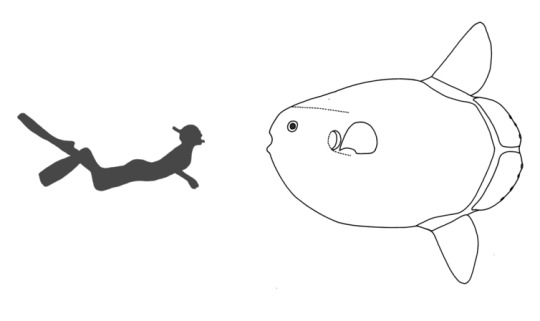
Illustration by Michelle Freeborn, Wellington Museum Te Papa Tongarewa.
53 notes
·
View notes
Link
அதிசய கடல் உயிரினம்
1 note
·
View note
Photo

(光与夜之恋 Light and Night) Osborn’s 5✩ Inspiration: Sleepless Starry Sea [星海无眠] Date Translation (Prologue)
“So, are you covering my ears now because it's thundering in the exhibition hall?”
*Light and Night Master-list | Osborn’s Personal Masterlist
*Spoiler free: Translations will remain under cut
*Join the Light & Night Discord (^▽^)~ ♪
*This 5✩ Inspiration has 5 Endings!!
*Osborn’s tag will be #For Night, For Freedom
*Requested by a friend, reblogs and likes appreciated!
*This Date comes after this Event! Please read it first~

I've heard many stories about the ocean, but I've never actually gone and understood the ocean.
And now, as I mulled over my new design that had "the ocean" as the theme, Osborn had suggested bringing me to the Oceanarium.
❖☆———————————★❖

Standing in front of the long, winding corridors, it was only then that I realized… that the very ocean had been slowly unravelled before our very eyes.
Clear and bright blue light encased the entire area as huge fishes swam past overhead. Their scales glinted faintly in the light, reflecting a multitude of colour down below.
And beneath our feet was the ocean, deeper, darker…
My footsteps faltered as an instinctive terror gripped me. For a moment, I didn't quite know what to do.

Osborn: Why aren't you walking?
MC: Oh… The corridor's too attractive, so I'm walking slower because I want to look at it longer.
The corners of his lips curved upwards as he headed towards me.
Osborn: Sorry, but I can't wait for you.
He then smoothly took my hand, balled into a fist from my nervousness, into his own.
He tugged gently, dragging me alongside him as we traversed the deep sea together.

MC: Thanks.
Osborn: Mm.
Then, I felt his long, slender, fingers slide between my fingers, domineering and powerfully intertwining our hands together.
Osborn: I much prefer this method of showing gratitude.
MC: …...
I gripped back, feeling the warm response from his palm.
❖☆———————————★❖

It was only after I passed the transparent corridor that my "leisurely stroll through the sea" really started.
My vision became brighter as colourful tropical fishes endlessly swirled around. It was almost as if we'd been pulled into a fantasy; of the wondrous Oceans in Fairytales
MC: The colour schemes of these tropical fish are really bold…
MC: Looks like I won't be going back empty-handed this time!
A faint smile played at the corner of his lips as he turned around to ruffle my hair.

Osborn: I hope the same goes for me too.
Before I could react, Osborn tugged me along, moving deeper into the depths of the oceanarium.
After a while, we strolled into a vast, open and bright area.
The ceiling in this area was inlaid with a huge transparent sheet of glass. The afternoon light shone in, spilling into the waters.
There were a couple of huge fishes leisurely “lying” at the surface, basking in the rays of the sun.
MC: Fishes sun tan? But this one’s so huge and it looks really strange… What kind of fish is this?
Puzzled, I suddenly noticed the explanatory board that was partially obscured in the dark.
MC: Lemme see… this fish is called Hoo-
The words “Hoodwinker” came into view. I jolted, subconsciously letting go of Osborn’s hand as I darted in front of the explanation display board, physically blocking it.

MC: H-Headfish! This fish can play cat's cradle; can you believe it? Aha, it's really amazing!
Osborn raised his now empty hands, arched an eyebrow, and looked at me with a playful expression.
Osborn: It's pretty amazing, yes.
MC: Haha, there's nothing worth looking at here. How about we go somewhere else?
Osborn: Not gonna wait for this fish to do some cat's cradle thing for us?

MC: No need. What's so nice about watching a fish play cat's cradle? I'll do it for you next time if you want to see it that badly!
Brushing it off with a laugh, I pushed Osborn into another direction, unable to help feeling a little miffed.
MC: Why’s this fish called “Hoodwinker” of all things? Osborn has a competition tomorrow; that’s way too inauspicious!
In order to prevent Osborn from noticing anything amiss, I could only do one thing: Keep “self-sacrificing” till I divert his attention elsewhere… I purposely stepped on his shoelaces, telling him that fishes were flying above as I held onto the explanation display board, feigning dizziness.
My acting was clearly over the top and forced, but fortunately enough, Osborn didn’t seem all too interested in the “Headfish”, so everything proceeded smoothly enough.
We were just about to leave this area for good when a little boy suddenly exclaimed from behind.
Kid In Passing: Mommy! This fish has such a weird name! Hood-
MC: Wait a minute-!
❖☆———————————★❖

A cacophony of alarm bells went off in my head! As quick as wildfire, I quickly rushed before Osborn, jumped up, and tugged him downwards by the neck
Osborn was pulled down, his frame bent over mine in surprise as he was caught off-guard, my hands tightly pressed against his faintly red ears.
Osborn: …!?
It wasn’t till the little boy walked off with his mother that I slowly lightened up.
Osborn: You…
Raising my eyes, I collided with the depths of Osborn's clear and bright orbs.
He stared at me for a fleeting moment, his warm breath hitting the top of my nose, brushing against my cheeks in a ticklish manner.
I blushed, attempting to withdraw my hands that were still covering his ears, only for him to hold it firmly back down.
Osborn: So, are you covering my ears now because it's thundering in the exhibition hall?
❖☆———————————★❖

MC: Y-Yes! How smart!
MC: The equipment up in the broadcasting room collapsed earlier! It sounded way more terrifying than thunder, it frightened me...*Coughs*
The words came out in such a rush that I accidentally choked on them.
Osborn chuckled, helping me pat my back before taking out a bottle of mineral water, unscrewing it before handing it to me.
Osborn: Have a drink. No rush.
Osborn: Must be hard putting up an act the entire way through, no?
MC: ...Huh!?
As I looked at him in astonishment, Osborn held my shoulder and turned me to face the other side.
Osborn: Look.
I glanced in the direction he was pointing at.
There was a lazy hoodwinker basking leisurely in the sun in one of the glass tanks of the exhibition area.
MC: Oh! It's a Hood...
Osborn: Yeah. Hoodwinker.
Osborn: But you can always call it a “Sunfish” if you don’t like the name that’s been put onto the display board.
MC: You…

Osborn: D'you think I'm similar to that dumb-looking fish?
MC: Of course not!
Osborn: Then, what are you so panicky about?
Osborn raised his fingers and gently flicked them against my forehead.
Osborn: There's no need to let your thoughts run wild. The one standing here right next to you now is none other than Osborn himself.
Rubbing my head, I stared at his usual devilish smile in slight disbelief.
MC: You already knew what it was called?
Looking at the unfazed smile on his face, I then realized that all my blatant efforts to cover it up were all for nought, and that I must have looked exceedingly stupid in his eyes.

MC: If you already knew it, then why didn't you tell me?
Osborn: Because…
Osborn: Letting you be all considerate about me like that feels rather nice.
The magnetic and deliberately lowered tone of his voice graced my ears, and I could suddenly feel my heartbeat pick up.

Osborn: Shall we continue?
Osborn instantly took my hand into his again, and the previous embarrassment I felt melted away, giving way to the faintly growing sweetness that started to well up from the bottom of my heart.
Where do I want to go next?
⊹ ˚✩ ━━━━━━━━━━━ ∘◦ ✥ ◦∘ ━━━━━━━━━━━ ✩˚ ⊹

✥ Choose your Ending:
END 1 | Choice: Do Nothing [都不做]
END 2 + 3 | Choice: Approach [亲近] ⊹Touch⊹
END 4 | Choice: Listen [倾听] ❖ASMR
END 5 | Choice: Heart-throb [心动] ★Night★
❖☆————— ⊹ For Night, For Freedom⊹ —————★❖
#光与夜之恋#Light and Night#Otome#Translations#Tencent#萧逸#Osborn#For Night For Freedom#星海无眠#Sleepless Starry Sea
22 notes
·
View notes
Photo

Name: Mola mola
Debut: The Ocean
I love Molas so much, I’m doing ANOTHER post on them! Last year’s just wasn’t enough! But I’ve also realized... last year’s was a bit problematic.
Even as someone who considers the silly sunfish to be one of their favorite animals, if not their number one, I fell victim to sensationalism. I’ve consumed a great deal of Mola content, but not all of it quite unbiased, and I let that bias leak into my own brain and drip out in the form of that post.
And that is wrong! I’m just perpetuating the stereotypes, and even if they weren’t stereotypes that make people disrespect the species, they would still be misinformation, and that’s never good to spread. So I am going to go over WHY I was wrong!

First of all, the Mola mola does not “suck at existing”. If it did, it wouldn’t exist! There is no animal that’s better than any other at existing. They’re all here because they excel in their niche enough to survive and reproduce! Even extinct animals weren’t bad at existing, because if they were, why would they evolve such detrimental traits in the first place? An animal’s features and abilities can’t protect it from meteors or poachers!

Would such an incapable fish be able to live all over the world’s oceans? I don’t think so! How many humans live in the ocean? None. Yes, I know fish could not feasibly survive on land, but humans have all sorts of technology for breathing underwater, and yet here we are, a bunch of landlubbers. (Note: I do not want humans to actually live in the ocean that would be a terrible idea don’t do it)
I pointed out in last year’s post that the idea of Mola molas being so slow that they go with the currents is outdated. But I didn’t do much to refute that, either! In fact, I had the gall to say they couldn’t swim very well at all. Geez! I really thought that post was okay! I’ve been uptight about scientific accuracy in regard to animals my whole life, and there I was being blatantly wrong about one of my all time favorites.

Hey, 2019 me? If you’re going to to talk about how slow they apparently are, how didn’t you realize how contradictory it was to immediately transition to their ability to leap out of the water at high speeds? Dummy. In order to do this, they have to be fast, and indeed, they are! Flapping their dorsal and anal fins and using their clavus as a rudder, they swim unlike any other fish... but that certainly doesn’t mean they do it WORSE.
In fact, in some ways, they’re BETTER! Most fish have a swim bladder, but Molas do not, and instead have gelatinous tissue that makes them neutrally buoyant. This allows them to easily swim even vertically! And they need to do that, because they are active hunters, diving to the cold, dark depths in search of food! And that’s far more than just jellies. They’re capable predators!
It’s true that Molas have parasites upon parasites... but so what? They’re great at dealing with them! They’ll breach the surface and even enlist the help of other animals, be they birds, fish or otherwise, to help. The closest thing I can think of for humans is those spas where little fish nibble away your dead skin! And of course, we have microscopic creatures living all over us, so we’re really not in any position to deride an animal for having parasites.
So in conclusion, the Mola mola is not a pathetic excuse for an animal. It’s weird, goofy, and downright confusing, but that by no means makes it bad! Having worked on this blog for over two years, you know very well that I value weirdness with all my heart. I’d much rather things be weird than not. It’s way more interesting, and often even funny!
And this is all just about a funny fish. Could you imagine if there were more dire matters that misinformation and stereotypes could affect? To think, there could be real people in the world being hurt by harmful ideas spread just because they’re different.

Anyway, here are some information sources!
https://asknature.org/strategy/tissue-provides-neutral-buoyancy/
https://oceansunfish.org/parasites-and-predators/
Time for some more fictional Mola molas I didn’t know about this time last year!

Manbou from Sonic Lost World, a Mola mola Badnik!

Ogyon and Ogyan from Densetsu no Starfy 2!

Bobfin from the Starfy series as a whole!

A robotic Mola seen in the background of Bubble Man’s stage in Mega Man 2: The Power Fighters!
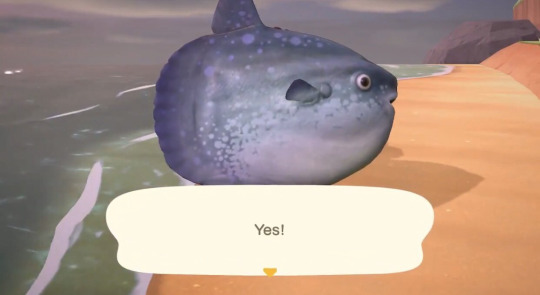
With the release of New Horizons, the Animal Crossing Mola is more impressive than ever!
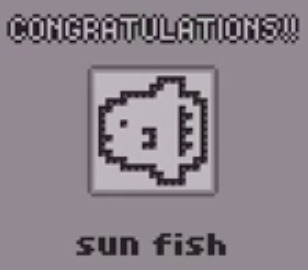
A sunfish appears as a puzzle in Mario’s Picross...

...as well as in Picross 3D!
Oh, and one last thing... those sunfish photos at the beginning of this post? Those weren’t Mola mola. Those were Mola TECTA! You’ve been hoodwinked by none other than the Hoodwinker Sunfish! April Fools!
89 notes
·
View notes
Text
Major Mola Moment: First Confirmed Hoodwinker Sunfish Photographed in Monterey Bay!!

Consider this your o-fish-al welcome to Monterey Bay, Hoodwinker Sunfish! You certainly had us fooled 😅
Divers in Monterey Bay have photographed two hoodwinker sunfish this year—the first confirmed sightings of this new species of sunfish in Central California!
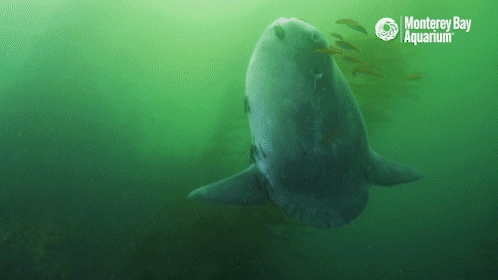
A hoodwinker sunfish being cleaned by señorita wrasses off of Pacific Grove. Video: Joe Platko
Known to science as Mola tecta, the hoodwinker sunfish was officially described in 2017 by Dr. Marianne Nyegaard at Australia’s Murdoch University.
The word “tecta” is Latin for hidden—a perfect moniker for a hoodwinker. Mola tecta were thought to live mainly in the cold waters around Australia, New Zealand, South Africa and Southern Chile.
But then, earlier this year, a massive hoodwinker sunfish washed up in Santa Barbara!
This sighting of Mola tecta was tantalizing for sunfish researchers: Are hoodwinkers new arrivals to the area, carried by Chile’s cool Humboldt current and somehow punching their way through the equator and into our temperate waters due to some climatic abnormality? Or have hoodwinkers been around these parts for some time, hiding in plain sight until Marianne’s discovery gave attentive observers the right clues to look for? Maybe a little bit of both? Something else entirely?
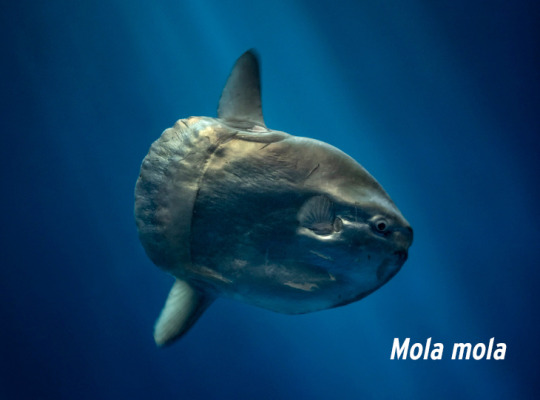
Mola mola, known as the common sunfish, in the Open Sea display at the Aquarium

Mola tecta found in Monterey Bay just offshore of Pacific Grove. This was the first confirmed sighting of a Mola tecta in Monterey Bay. Photo: Jr Sosky

Key characteristics of Mola tecta for identification. Photo: Jr Sosky/Marianne Nyegaard
A blessing in disguise
Whatever the case, there are now at least two more Mola tecta confirmed here in California, and the first ever identified in Monterey Bay.
In early August, a merry band of underwater photographers came across a large ocean sunfish being cleaned by señorita wrasses at Eric’s Pinnacle, a rocky outcrop off Lover’s Point in Pacific Grove.
We shared an image on the Aquarium’s social media feeds by photographer Joe Platko under the guise of a “Mola mola Monday Motivoceanal Moment!”
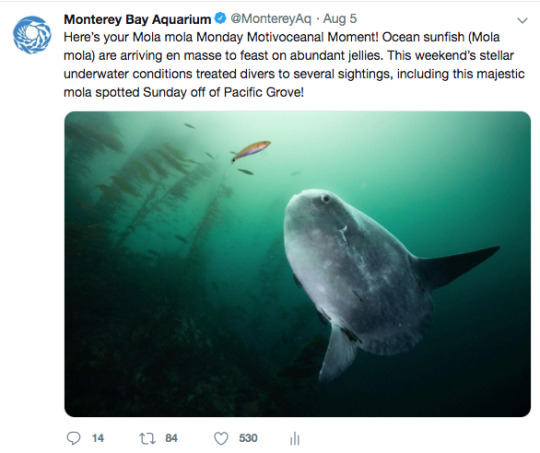
Our (erroneous) post on Twitter. More social media copy mistakes that lead to discoveries of new sunfish species in our backyard, please!
Mola mola is no stranger to the Monterey Bay—we see youngsters and heavyweights throughout the year just offshore of the Aquarium, and we’ve frequently had them on display in the Open Sea.
(You may know Mola mola better from the expletive-ridden video of a Boston fisherman coming across a sea monster in this viral video https://youtu.be/r0IQCLQDfKw , or perhaps you’ve read the decidedly contrarian hate-click account of how “useless” sunfish are. )
Weighing nearly 5,000 pounds and spanning over 11 feet from tip to tip, Mola mola is one of the heaviest bony fishes in the sea (its Western Pacific cousin, the bumphead sunfish Mola alexandrini is just a touch heavier in the record books.)
Something fishy about that fishy...
Content with our content, we looked to see what you all thought of this magical “Mola mola”—and that’s when things got exciting!
A comment right here on Tumblr by Drop Science mentioned that this fish looked more Mola tecta than Mola mola. The two are remarkably similar in appearance, but there are a few tells. Most noticeably, a Mola tecta caudal fin is is divided by a smooth band projecting backwards to the fin’s edge.
Intrigued, we forwarded more images from Joe Platko and his dive buddy Jr Sosky to Senior Aquarist and resident mola expert Michael Howard.
youtube
Michael has been instrumental in our ocean sunfish program at the Monterey Bay Aquarium over several decades, pioneering training methods, specialized diets and tracking programs for these megafish. The Aquarium is the only one to successfully display Mola mola in North America.
Growing from just a few dozen pounds to several hundred, our resident sunfishes are released back to the wild. Once back in the bay, Michael’s satellite tags have revealed that Mola mola may migrate very far up and down the coast, and spend considerable time diving into the deep sea to feed on a varied diet of jellies, squid, crabs and other fare.
After reviewing the images, Michael thought there was certainly the chance that a hoodwinker had been found. He got us in touch with Marianne Nyegaard herself, and she confirmed that these were indeed the first images of a live Mola tecta in Monterey Bay!
Then, just three weeks later, diver Wei Wei Gao happened upon another Mola tecta off of Cannery Row!!

A hoodwinker sunfish filmed off Cannery Row. Video: Wei Wei Gao
A tecta-nic shift in our sunfish understanding!
In email exchanges that used up both of our yearly supplies of exclamation points, Dr. Marianne remarked that these sightings show just how little we know about one of the ocean’s most iconic fishes.
Michael is now diving into our records to see if there’s a chance we have had a Mola tecta hidden in our studies. And as for us, we’re buzzing with excitement at the discovery of this neighbor in our backyard, pleasantly deceived by a hoodwinker sunfish, and awestruck by the limitless wonder and mystery of our beloved Monterey Bay.
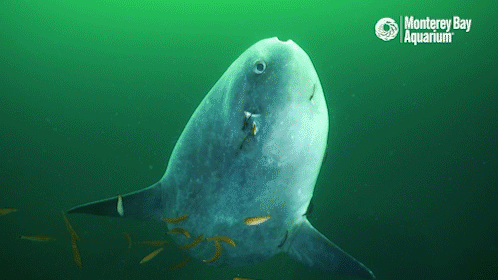
The first-ever confirmed Mola tecta in Monterey Bay being cleaned by señorita wrasses. Welcome to the neighborhoodwinker! Video: Joe Platko.
#monterey bay aquarium#mola mola#mola tecta#hoodwinker sunfish#ocean sunfish#Marianne Nyegaard#Michael Howard#major mola moment!
2K notes
·
View notes
